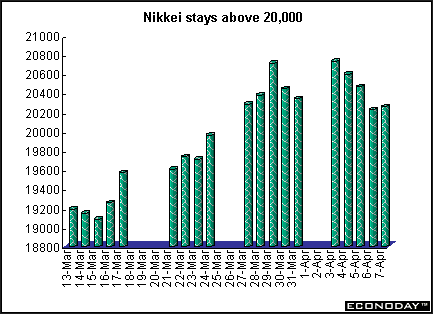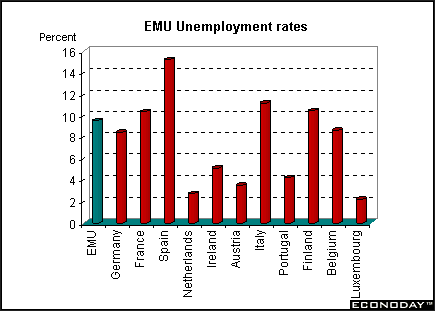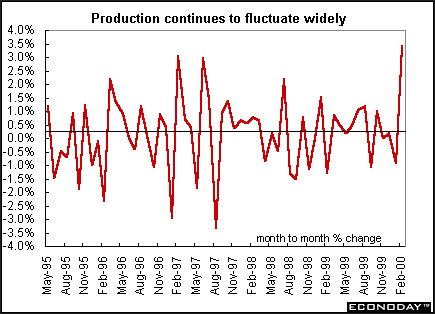| Previous Articles |
|
The
week that was
Asia On Monday, despite the unexpected change in political leadership following Prime Minister Obuchi's stroke and given no surprises in the tankan survey, the Nikkei percolated along in a business as usual fashion and greeted the new fiscal year enthusiastically. However, the Nikkei slipped the next three days, but stemmed the losses as U.S. stocks stabilized. Another stabilizing factor was the expectation that new investment funds currently being launched (to take advantage of vast postal savings that will mature in the next two years) will buy a variety of stocks for their portfolios.
The Hong Kong Hang Seng traded lower as the chills from Wall Street prompted a wide sell off spreading from blue chip telecommunication companies to fledgling "dot.coms". The Hang Seng, which at one stage fell 646 points, ended the week down 2.67 percent at 16,942. Traders said some rotational buying limited the losses as investors took refuge from the global technology rout in banks and utilities.
Europe
and Britain
It would have been difficult to persuade London investors on Tuesday — with the Dow down over 500 points, the Nasdaq dropping 575 points, and the FTSE 100 closing lower — that the market would finish the week little changed and generally in robust fashion. What’s more, troubles were compounded on Wednesday by an eight hour trading systems breakdown, just the day after Wall Street’s gyrations and the last day of the UK financial year. But that was exactly the case on Friday as a fresh burst of support for the sectors that provoked all the mayhem, technology, media and telecommunication stocks or TMTs, drove the FTSE 100 sharply higher for a second consecutive session. It was not just a revival of the TMTs, however. Market sentiment was still being boosted by Thursday’s decision from the Bank of England's monetary policy committee to leave interest rates on hold. Driven by a combined 3 percent rise on Thursday and Friday, the FTSE 100 ended the week up 29.7 points or 0.45 percent at 6,570. The DAX ended the week down 77 points or 0.83 percent at 7,522, while the CAC ended the week up 22 points or 0.35 percent at 6,308. Currencies The
euro continues to founder
The
Bank of Japan intervenes
A rapid rise in the yen is undesirable for Japan because it could derail the country's nascent economic recovery by making exports less competitive. There is speculation that finance ministers at the G-7 meeting will say, as they have at the last two meetings, that they share Japan's concern over a strong yen. Central
Banks The Bank of England's Monetary Policy Committee as expected left its policy making interest rate at 6 percent.
Indicator
scoreboard
The EMU Reuters' purchasing managers' index rose to a record high of 59.4 from 57.1 in February. In addition, the price index, which is not part of the overall PMI, rose strongly and hit a record high of 72.4 in March from 70.2 in February. The PMI is based on data from six countries — Germany, France, Italy, Spain, Ireland and Austria — and has been above 50 for twelve straight months. The services activity index rose to a seasonally adjusted 60.9 after 59.2 in February, indicating that the services sector expanded at a faster pace. Service sector input prices and prices charged also continued to rise. Input prices grew at a slightly faster pace while prices charged grew more slowly. In Germany, the March seasonally adjusted purchasing managers' index rose to 58.16, reaching the highest level in the index's four year history. The index is based on a survey of 350 firms. In France, the March seasonally adjusted purchasing managers' index manufacturing rose to a record 61.8. It has expanded for 14 straight months. In Italy, the March seasonally adjusted purchasing managers' index expanded for the ninth consecutive month. The index rose to 59.95 and stood at its highest level since the survey started in June 1997. In Britain, the March seasonally adjusted purchasing managers' index published by the Chartered Institute of Purchasing and Supply (CIPS) rose to 51.4. But the overall pace of expansion still remained below the second half of last year. However, input prices rose at their fastest rate since August 1995. Strong global demand and growing commodity shortages combined with higher oil prices continued to offset the deflationary impact of the strong pound. Other
indicators
The March European Commission's economic sentiment index hit a record 105.0 in March, up from 104.8 in February, reflecting a further gain in industrial confidence. However, the consumer confidence index was flat. February industrial producer prices rose 0.5 percent on the month and 5.7 percent on the year. The 0.8 percent rise in intermediate goods prices, which includes oil and other commodities, was the main factor contributing to the increase. Intermediate prices were up 9.2 percent when compared with last year. Germany — February wholesale sales rose a seasonally and calendar adjusted 4.0 percent in February, while real sales were up 2.8 percent. Overall wholesale sales jumped 17.9 percent in nominal terms compared to a year earlier, and were up 10.6 percent after adjustment for inflation. All major wholesale sales categories except agricultural products posted strong real sales increases in February. February preliminary seasonally adjusted manufacturing orders rose 4.7 percent on the month and 12.5 percent on the year. The increase was largely due to strong domestic demand. February seasonally adjusted industrial production rose 3.4 percent and 6.4 percent on the year boosted by a construction surge from milder than usual weather. Fourth quarter industrial production grew 0.7 percent. West German fourth quarter industrial production was revised down to a 0.7 percent increase from the previous quarter while production in east Germany was revised up to 2.1 percent on the quarter.
Britain — March seasonally adjusted Halifax Building Society survey of house prices fell 0.4 percent. However, the figures are at odds with a rival survey recently compiled by Nationwide building society, which indicates that prices actually rose by 2.3 percent. On the year prices are still up, by 13.5 percent.
February manufacturing output fell by 0.2 percent but was up 1.5 percent on the year. In the three months to February, manufacturing output fell 0.5 percent on the quarter and was up by 1.7 percent on the year. Total industrial production fell by 0.6 percent on the month and was up 1.1 percent on the year. In the three months to February, total industrial output fell by 0.8 percent on the quarter but was up 1.5 percent on the year. The Chartered Institute of Purchasing and Supply (CIPS) survey's business activity index rose to a seasonally adjusted 59.6, the highest level since June 1997. Almost 30 percent of companies reported increased activity, some three times the number that reported a downturn. Greater demand for services in part reflected a Millennium effect. Business activity in the services sector has expanded for 13 months in a row, with the increased growth rate in March driven by a marked rise in new business. The incoming new business index rose to a seasonally adjusted 58.0 from 57.4 in February. Asia
February household spending rose a real 4.2 percent when compared with last year. Spending for all households was up a nominal 3.3 percent on the year. Spending by wage earner households was down 1.8 percent in nominal terms and down 0.9 percent in real terms on the year. The average propensity to consume for all households was 76.3 percent, up from 73.5 percent February a year ago. Australia — March unemployment rate rose to 6.9 percent from February's 6.7 percent, reflecting an increase in the number of job seekers looking for work. The participation rate — or the proportion of the working age population in the labor force — rose to 63.6 percent from 63.5 percent in February. Employment has grown 2.9 percent in the 12 months to February and more than 70 percent of that growth has been in full time, rather than part time jobs.
Americas
BOTTOM LINE Looking Ahead: April 10 to April 15, 2000
|
||||||||||||||||||||||||||||||||||||||||||||||||||||||||||||||||||||||||||||||||||||||||||||||||||||||||||||||||||||||||||||||||||||||||||||||||||||||||||||||||||||||||||||||||||||||












